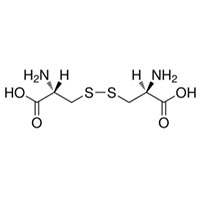Synonyms
D,L-cystine
meso-Cystine
UNII:06681CV9GH
(S)-Cystine
Cystine, D-
D(+)-CYSTINE
MFCD00002610
D-Cystine
D-CYSTINE CRYSTALLINE
H-D-CYSTINE
EINECS 206-486-2
H-D-(Cys)2-OH
Product Description
D-Cystine is a non-essential amino acid that can be synthesized in the human body by the oxidation of
cysteine. It is a dimer of two cysteine molecules linked by a disulfide bond. D-Cystine has various
applications in the pharmaceutical, nutritional, and cosmetic industries.
In the pharmaceutical industry, D-Cystine is used as a building block for the synthesis of
cysteine-containing drugs, such as N-acetylcysteine, which is used to treat respiratory disorders. It is
also used as a raw material for the production of glutathione, an important antioxidant that protects
cells from damage caused by reactive oxygen species.
In the nutritional industry, D-Cystine is used as a dietary supplement to enhance protein synthesis and
promote muscle growth. It is also used in sports nutrition products to help athletes increase their
muscle mass and improve their athletic performance.
In the cosmetic industry, D-Cystine is used as an ingredient in hair care products, such as shampoos and
conditioners, to strengthen hair and promote hair growth. It is also used in skin care products to help
reduce the appearance of wrinkles and fine lines.
The production of D-Cystine involves the chemical synthesis of cysteine followed by oxidation to form
the disulfide bond. D-Cystine is available in the form of a white crystalline powder and is sold by
various chemical suppliers.
The global market for D-Cystine is driven by the increasing demand for cysteine-containing drugs, the
growing awareness of the importance of antioxidants in preventing diseases, and the rising demand for
sports nutrition products. The major players in the D-Cystine market include Ajinomoto, Evonik
Industries AG, and Wuxi Enovo Chemical Co., Ltd.
In conclusion, D-Cystine is a versatile amino acid with various applications in the pharmaceutical,
nutritional, and cosmetic industries. Its production involves chemical synthesis and it is available in
the form of a white crystalline powder. The global market for D-Cystine is expected to continue to grow
in the coming years due to the increasing demand for cysteine-containing drugs, antioxidants, and sports
nutrition products.





